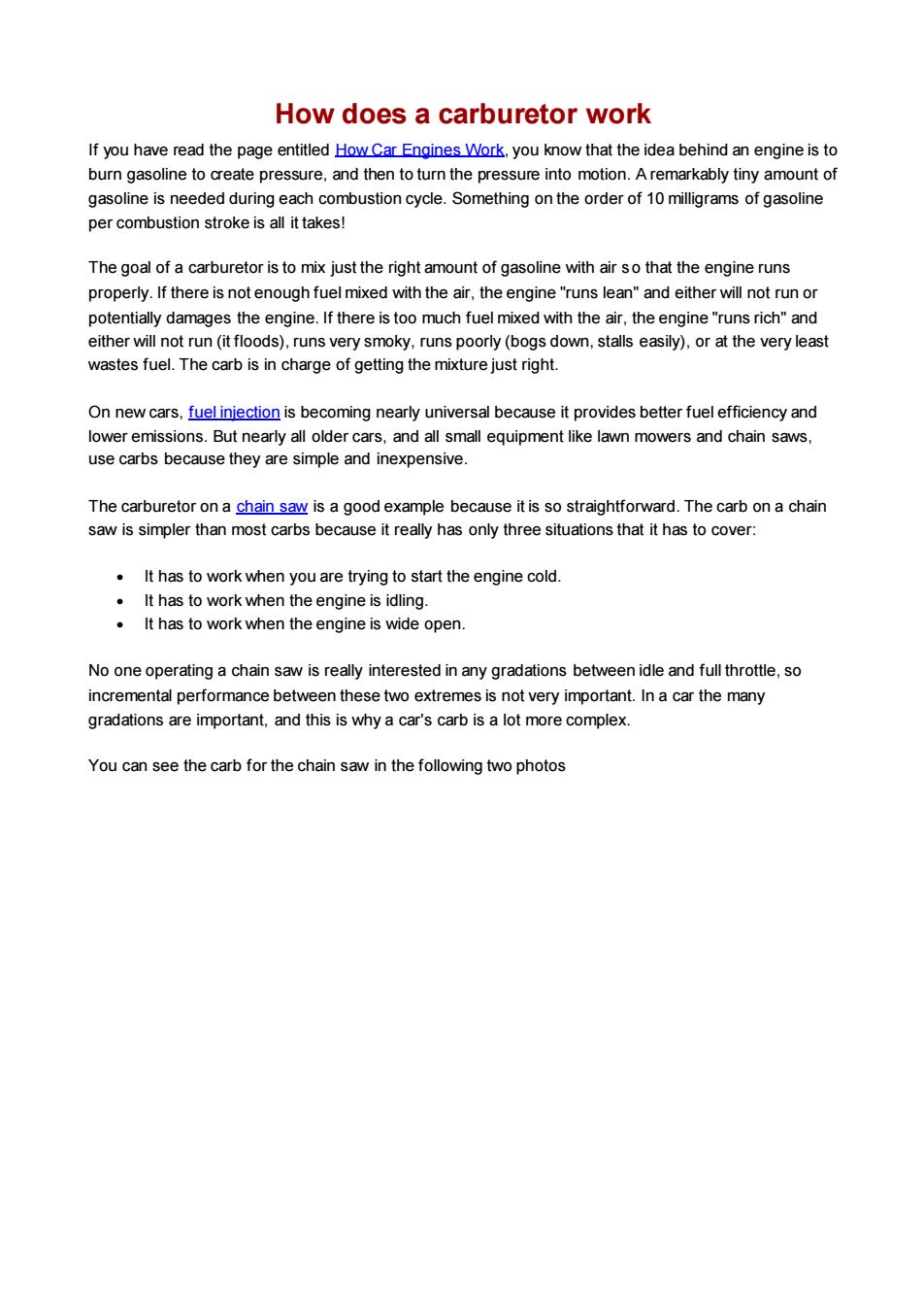
HowdoesacarburetorworkIf youhavereadthepageentitledHowCarEnginesWork,youknowthattheideabehindanengineistoburngasolineto createpressure,andthentoturnthepressure into motion.Aremarkablytinyamountofgasoline is needed during each combustion cycle. Something on the order of 10milligrams of gasolinepercombustionstrokeisall ittakes!The goal of a carburetor is to mix just the right amount of gasoline with air so that the engine runsproperly. If there is not enough fuel mixed with the air, the engine "runs lean" and either will not run orpotentially damages the engine. If there is too much fuel mixed with the air,the engine"runs rich"andeither will not run (it floods),runs very smoky,runs poorly (bogs down, stalls easily), or at the very leastwastes fuel.The carb is in charge of getting the mixture just right.On newcars,fuel iniection is becomingnearly universal because it providesbetterfuelefficiencyandlower emissions. But nearly all older cars, and all small equipment like lawn mowers and chain saws.usecarbsbecausetheyaresimpleandinexpensive.The carburetor on a chain saw is a good example because it is so straightforward. The carb on a chainsawissimplerthanmostcarbsbecauseitrealyhasonlythreesituationsthatithastocoverIt has to work when you are trying to start the engine cold.It has to work when the engine is idling.It has to work when the engine is wide openNo one operating a chain saw is really interested in any gradations between idle and full throttle, soincremental performance between these two extremes is not very important. In a car the manygradations are important, and this is whya car's carb is a lot more complex.Youcanseethecarbforthechainsaw in thefollowingtwophotos
How does a carburetor work If you have read the page entitled How Car Engines Work, you know that the idea behind an engine is to burn gasoline to create pressure, and then to turn the pressure into motion. A remarkably tiny amount of gasoline is needed during each combustion cycle. Something on the order of 10 milligrams of gasoline per combustion stroke is all it takes! The goal of a carburetor is to mix just the right amount of gasoline with air so that the engine runs properly. If there is not enough fuel mixed with the air, the engine "runs lean" and either will not run or potentially damages the engine. If there is too much fuel mixed with the air, the engine "runs rich" and either will not run (it floods), runs very smoky, runs poorly (bogs down, stalls easily), or at the very least wastes fuel. The carb is in charge of getting the mixture just right. On new cars, fuel injection is becoming nearly universal because it provides better fuel efficiency and lower emissions. But nearly all older cars, and all small equipment like lawn mowers and chain saws, use carbs because they are simple and inexpensive. The carburetor on a chain saw is a good example because it is so straightforward. The carb on a chain saw is simpler than most carbs because it really has only three situations that it has to cover: • It has to work when you are trying to start the engine cold. • It has to work when the engine is idling. • It has to work when the engine is wide open. No one operating a chain saw is really interested in any gradations between idle and full throttle, so incremental performance between these two extremes is not very important. In a car the many gradations are important, and this is why a car's carb is a lot more complex. You can see the carb for the chain saw in the following two photos
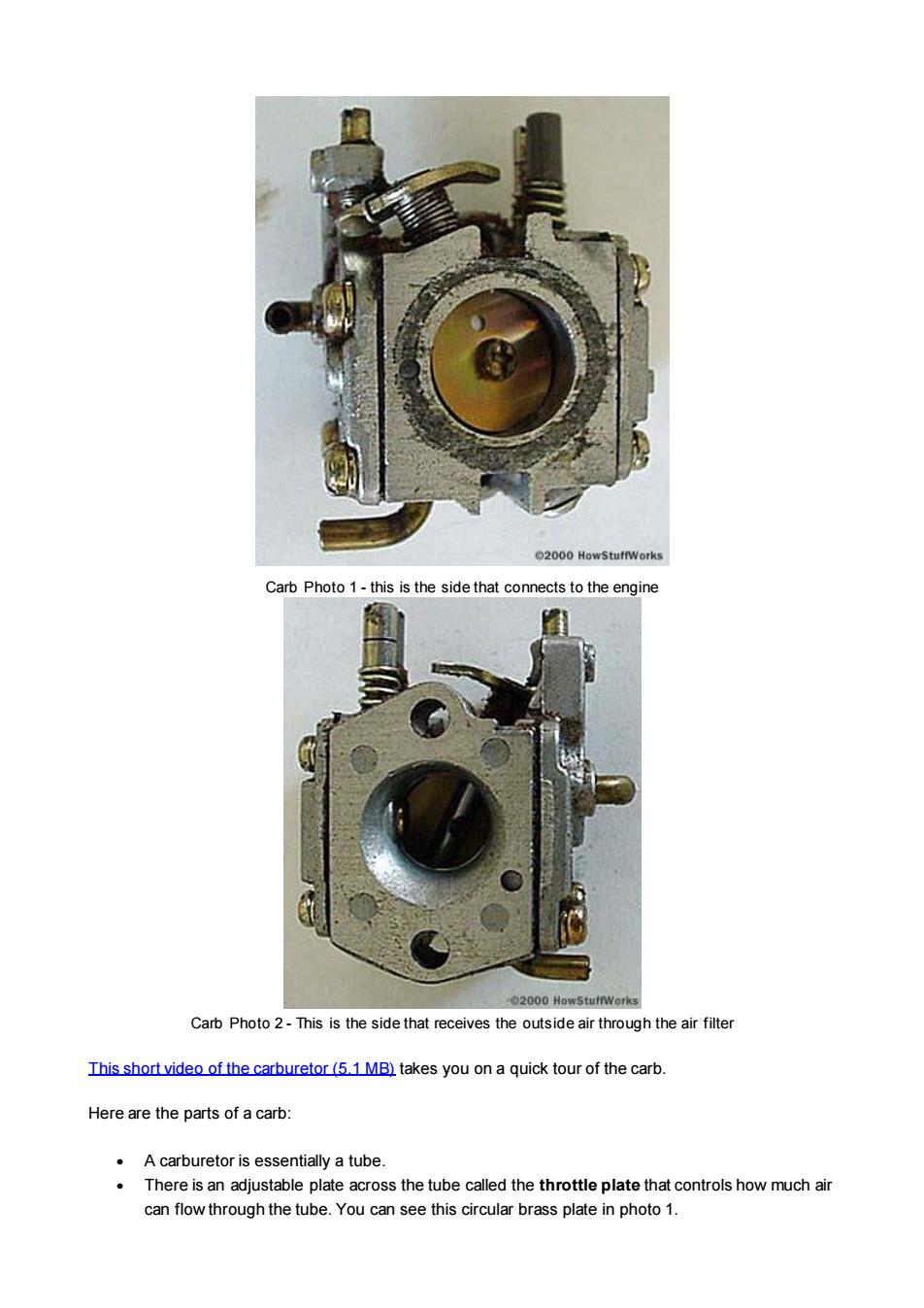
e2000HowstufrWorksCarb Photo1-this is thesidethat connectsto theengine@20ooHowstufrWorkCarb Photo2-This is the sidethatreceives the outsideair throughtheair filterThisshortvideoofthecarburetor(5.1MB)takesyouonaquicktourofthecarbHerearethepartsofacarb:AcarburetorisessentiallyatubeThereisanadjustableplateacrossthetubecalledthethrottleplatethatcontrolshowmuchaircanflowthroughthetube.Youcanseethiscircularbrassplateinphoto1
Carb Photo 1 - this is the side that connects to the engine Carb Photo 2 - This is the side that receives the outside air through the air filter This short video of the carburetor (5.1 MB) takes you on a quick tour of the carb. Here are the parts of a carb: • A carburetor is essentially a tube. • There is an adjustable plate across the tube called the throttle plate that controls how much air can flow through the tube. You can see this circular brass plate in photo 1
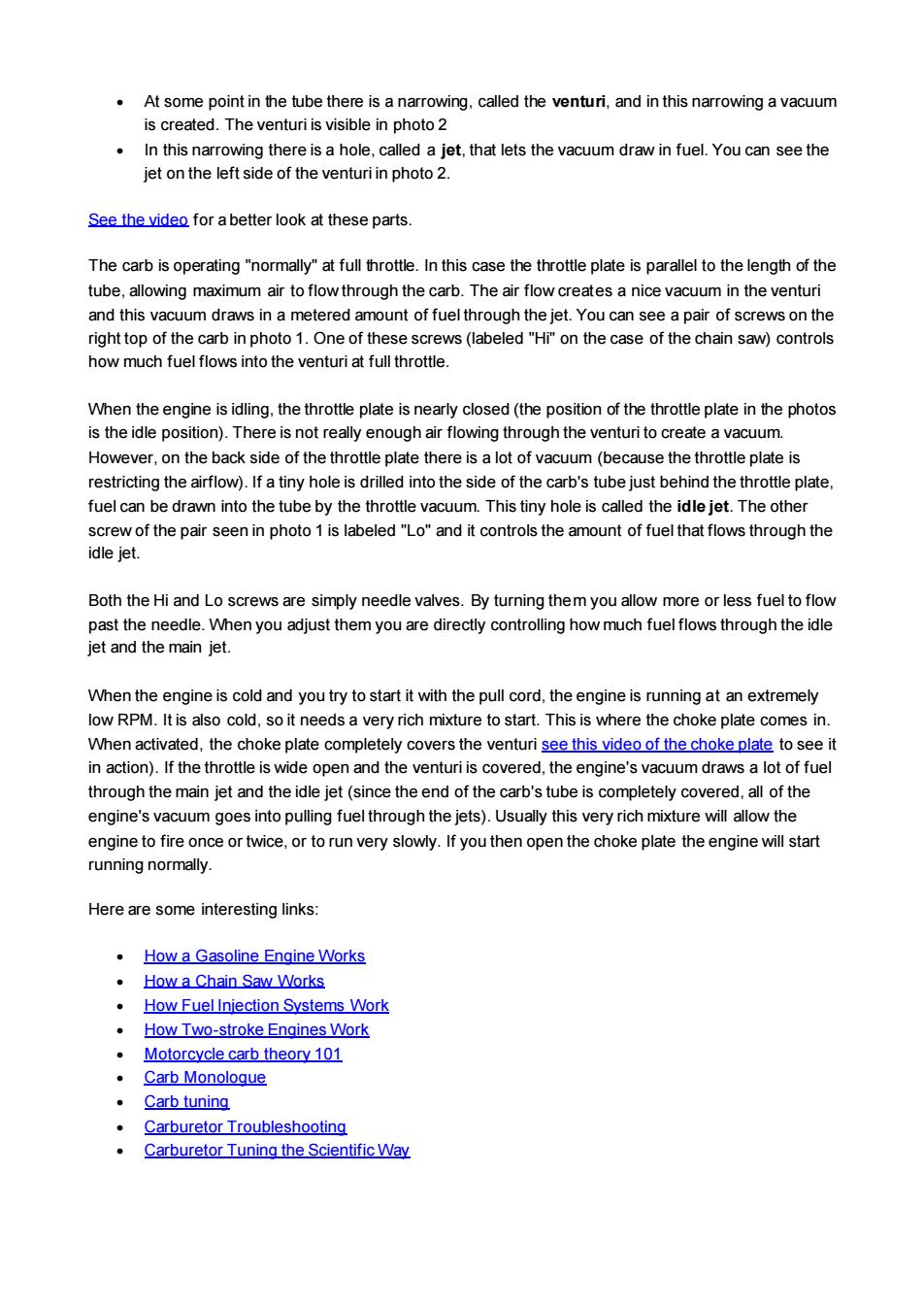
At some pointin the tube there is a narrowing, called the venturi, and in this narrowing a vacuumis created.The venturis visible in photo 2In this narrowing thereis a hole, called a jet,thatlets the vacuum draw in fuel.You can see thejetontheleftsideoftheventurinphoto2.See the videoforabetterlook at thesepartsThe carb is operating "normally" at full throttle. In this case the throttle plate is parallel to the length of thetube,allowingmaximumairtoflowthroughthecarb.Theairflowcreatesanicevacuumintheventuriandthisvacuumdrawsinameteredamountoffuelthroughthe jet.Youcanseeapairofscrewsontherighttopofthecarbinphoto1.Oneofthesescrews(labeled"Hi"onthecaseofthechainsaw)controlshowmuchfuelflows intotheventuriatfullthrottleWhentheengineisidling,thethrottleplateisnearlyclosed(thepositionofthethrottleplateinthephotosistheidleposition).ThereisnotreallyenoughairflowingthroughtheventuritocreateavacuumHowever,onthebacksideofthethrottleplatethereisalotofvacuum(becausethethrottleplateisrestrictingthe airflow).Ifatinyhole is drilled into theside of the carb's tube justbehind thethrottleplatefuel can be drawn into the tube by the throttle vacuum. This tiny hole is called the idle jet. The otherscrew of the pair seen in photo 1 is labeled "Lo" and it controls the amount of fuel that flows through theidle jet.Boththe Hiand Lo screws are simplyneedlevalves.Byturning themyou allowmore orless fuel toflowpasttheneedle.Whenyouadjustthemyouaredirectlycontrollinghowmuchfuelflowsthroughtheidlejet and the main jet.When the engine is cold and you try to start it with the pull cord, the engine is running at an extremelylowRPM.Itisalso cold,so it needsaveryrichmixturetostart.Thisiswherethechokeplatecomesin.Whenactivated,thechokeplatecompletelycoverstheventuriseethisvideoofthechokeplatetoseeitinaction).Ifthethrottleiswideopenandtheventuriiscovered,theengine'svacuumdrawsalotoffuelthroughthemain jet and the idlejet (sincetheend of thecarb'stube iscompletelycovered,all oftheengine'svacuumgoesintopullingfuelthroughthejets).Usuallythisveryrichmixturewillallowtheenginetofireonceortwice,ortorunveryslowly.Ifyouthenopenthechokeplatetheenginewill startrunningnormallyHere are some interesting links:Howa Gasoline EngineWorksHow a Chain Saw WorksHowFuellniectionSystemsWorkHow Two-stroke Engines WorkMotorcycle carb theory 101Carb MonoloqueCarb tuningCarburetor TroubleshootingCarburetorTuningtheScientificWay
• At some point in the tube there is a narrowing, called the venturi, and in this narrowing a vacuum is created. The venturi is visible in photo 2 • In this narrowing there is a hole, called a jet, that lets the vacuum draw in fuel. You can see the jet on the left side of the venturi in photo 2. See the video for a better look at these parts. The carb is operating "normally" at full throttle. In this case the throttle plate is parallel to the length of the tube, allowing maximum air to flow through the carb. The air flow creates a nice vacuum in the venturi and this vacuum draws in a metered amount of fuel through the jet. You can see a pair of screws on the right top of the carb in photo 1. One of these screws (labeled "Hi" on the case of the chain saw) controls how much fuel flows into the venturi at full throttle. When the engine is idling, the throttle plate is nearly closed (the position of the throttle plate in the photos is the idle position). There is not really enough air flowing through the venturi to create a vacuum. However, on the back side of the throttle plate there is a lot of vacuum (because the throttle plate is restricting the airflow). If a tiny hole is drilled into the side of the carb's tube just behind the throttle plate, fuel can be drawn into the tube by the throttle vacuum. This tiny hole is called the idle jet. The other screw of the pair seen in photo 1 is labeled "Lo" and it controls the amount of fuel that flows through the idle jet. Both the Hi and Lo screws are simply needle valves. By turning them you allow more or less fuel to flow past the needle. When you adjust them you are directly controlling how much fuel flows through the idle jet and the main jet. When the engine is cold and you try to start it with the pull cord, the engine is running at an extremely low RPM. It is also cold, so it needs a very rich mixture to start. This is where the choke plate comes in. When activated, the choke plate completely covers the venturi see this video of the choke plate to see it in action). If the throttle is wide open and the venturi is covered, the engine's vacuum draws a lot of fuel through the main jet and the idle jet (since the end of the carb's tube is completely covered, all of the engine's vacuum goes into pulling fuel through the jets). Usually this very rich mixture will allow the engine to fire once or twice, or to run very slowly. If you then open the choke plate the engine will start running normally. Here are some interesting links: • How a Gasoline Engine Works • How a Chain Saw Works • How Fuel Injection Systems Work • How Two-stroke Engines Work • Motorcycle carb theory 101 • Carb Monologue • Carb tuning • Carburetor Troubleshooting • Carburetor Tuning the Scientific Way
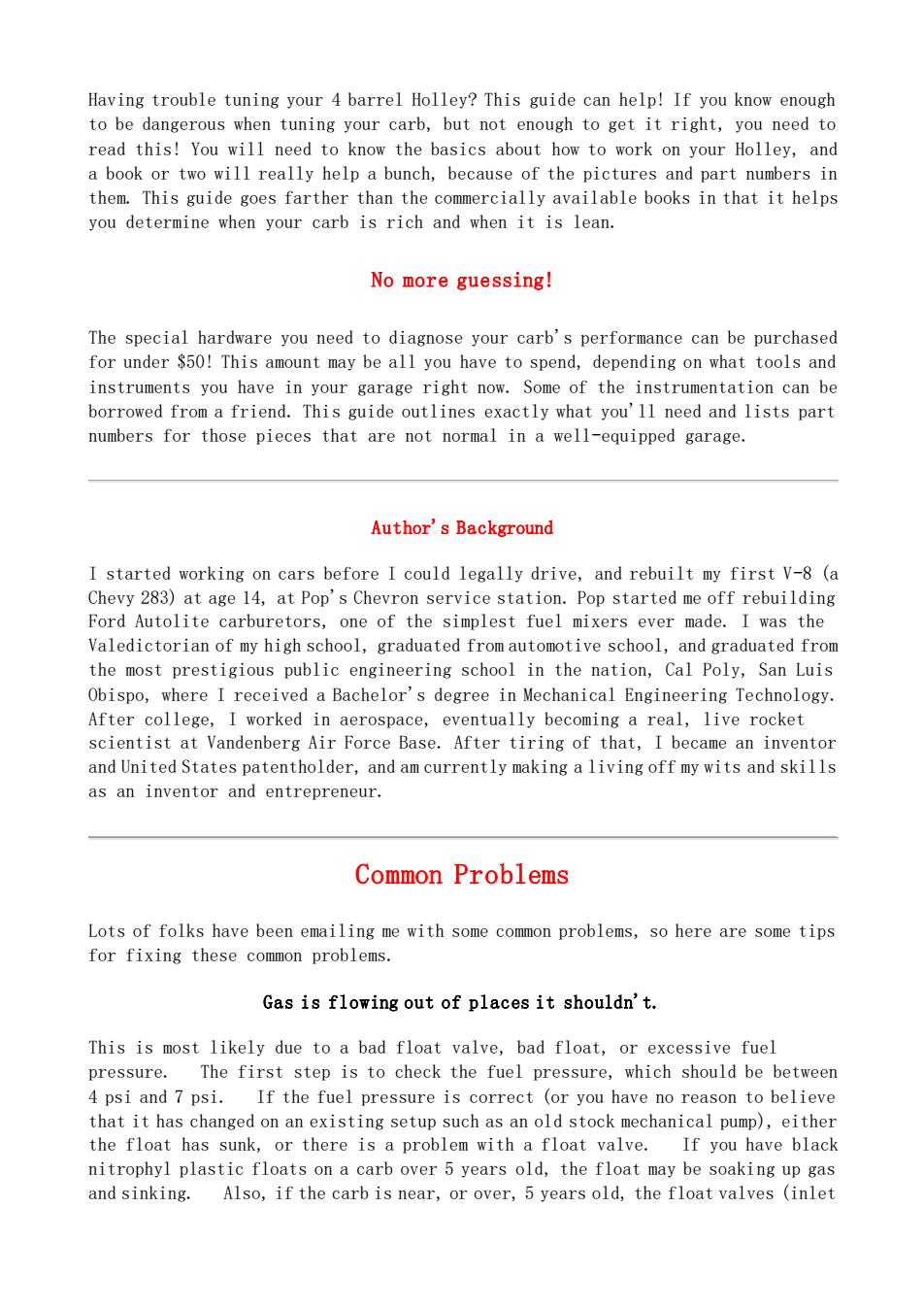
Having trouble tuning your 4 barrel Holley? This guide can help! If you know enoughto be dangerous when tuning your carb, but not enough to get it right, you need toread this! You will need to know the basics about how to work on your Holley, andabook ortwowillreallyhelpabunch,becauseof thepictures andpartnumbers inthem.Thisguidegoesfartherthanthecommerciallyavailablebooks inthatit helpsyou determine when your carb is rich and when it is lean.No more guessing!The special hardwareyou need todiagnose yourcarb'sperformancecan be purchasedforunders5o!Thisamountmaybeall youhavetospend,dependingonwhat toolsandinstruments you have in your garage right now. Some of the instrumentation can beborrowed from a friend. This guide outlines exactly what you'l need and lists partnumbers for those pieces that are not normal in a well-equipped garage.Author' s BackgroundI started working on cars before I could legallydrive, and rebuilt my first V-8 (aChevy283)atage14,atPop's Chevron service station.Pop startedme off rebuildingFord Autolite carburetors, one of the simplest fuel mixers ever made. I was theValedictorian of myhigh school, graduated fromautomotive school,and graduated fromthe most prestigious public engineering school in the nation, Cal Poly, San LuisObispo, where I received a Bachelor's degree in Mechanical Engineering Technology.After college, I worked in aerospace, eventuallybecoming a real,live rocketscientist at Vandenberg Air Force Base. After tiring of that, I became an inventorand United States patentholder, and am currently making aliving off my wits and skillsas an inventor and entrepreneur.Common ProblemsLotsof folkshavebeen emailingmewithsomecommonproblems,soherearesometipsforfixing these commonproblems.Gas is flowing out of places it shouldn't.This is most likely due to a bad float valve, bad float, or excessive fuelThe first step is to check the fuel pressure, which should be betweenpressure.4 psi and 7 psi.If thefuel pressure is correct (oryouhavenoreason to believethat it has changed on an existing setup such as an old stock mechanical pump), eitherIf youhave blackthefloat has sunk,orthereis aproblem with afloat valve.nitrophyl plastic floats on a carb over 5 years old, the float may be soaking up gasand sinking.Also, if the carb isnear, or over, 5 years old, the float valves (inlet
Having trouble tuning your 4 barrel Holley? This guide can help! If you know enough to be dangerous when tuning your carb, but not enough to get it right, you need to read this! You will need to know the basics about how to work on your Holley, and a book or two will really help a bunch, because of the pictures and part numbers in them. This guide goes farther than the commercially available books in that it helps you determine when your carb is rich and when it is lean. No more guessing! The special hardware you need to diagnose your carb's performance can be purchased for under $50! This amount may be all you have to spend, depending on what tools and instruments you have in your garage right now. Some of the instrumentation can be borrowed from a friend. This guide outlines exactly what you'll need and lists part numbers for those pieces that are not normal in a well-equipped garage. Author's Background I started working on cars before I could legally drive, and rebuilt my first V-8 (a Chevy 283) at age 14, at Pop's Chevron service station. Pop started me off rebuilding Ford Autolite carburetors, one of the simplest fuel mixers ever made. I was the Valedictorian of my high school, graduated from automotive school, and graduated from the most prestigious public engineering school in the nation, Cal Poly, San Luis Obispo, where I received a Bachelor's degree in Mechanical Engineering Technology. After college, I worked in aerospace, eventually becoming a real, live rocket scientist at Vandenberg Air Force Base. After tiring of that, I became an inventor and United States patentholder, and am currently making a living off my wits and skills as an inventor and entrepreneur. Common Problems Lots of folks have been emailing me with some common problems, so here are some tips for fixing these common problems. Gas is flowing out of places it shouldn't. This is most likely due to a bad float valve, bad float, or excessive fuel pressure. The first step is to check the fuel pressure, which should be between 4 psi and 7 psi. If the fuel pressure is correct (or you have no reason to believe that it has changed on an existing setup such as an old stock mechanical pump), either the float has sunk, or there is a problem with a float valve. If you have black nitrophyl plastic floats on a carb over 5 years old, the float may be soaking up gas and sinking. Also, if the carb is near, or over, 5 years old, the float valves (inlet
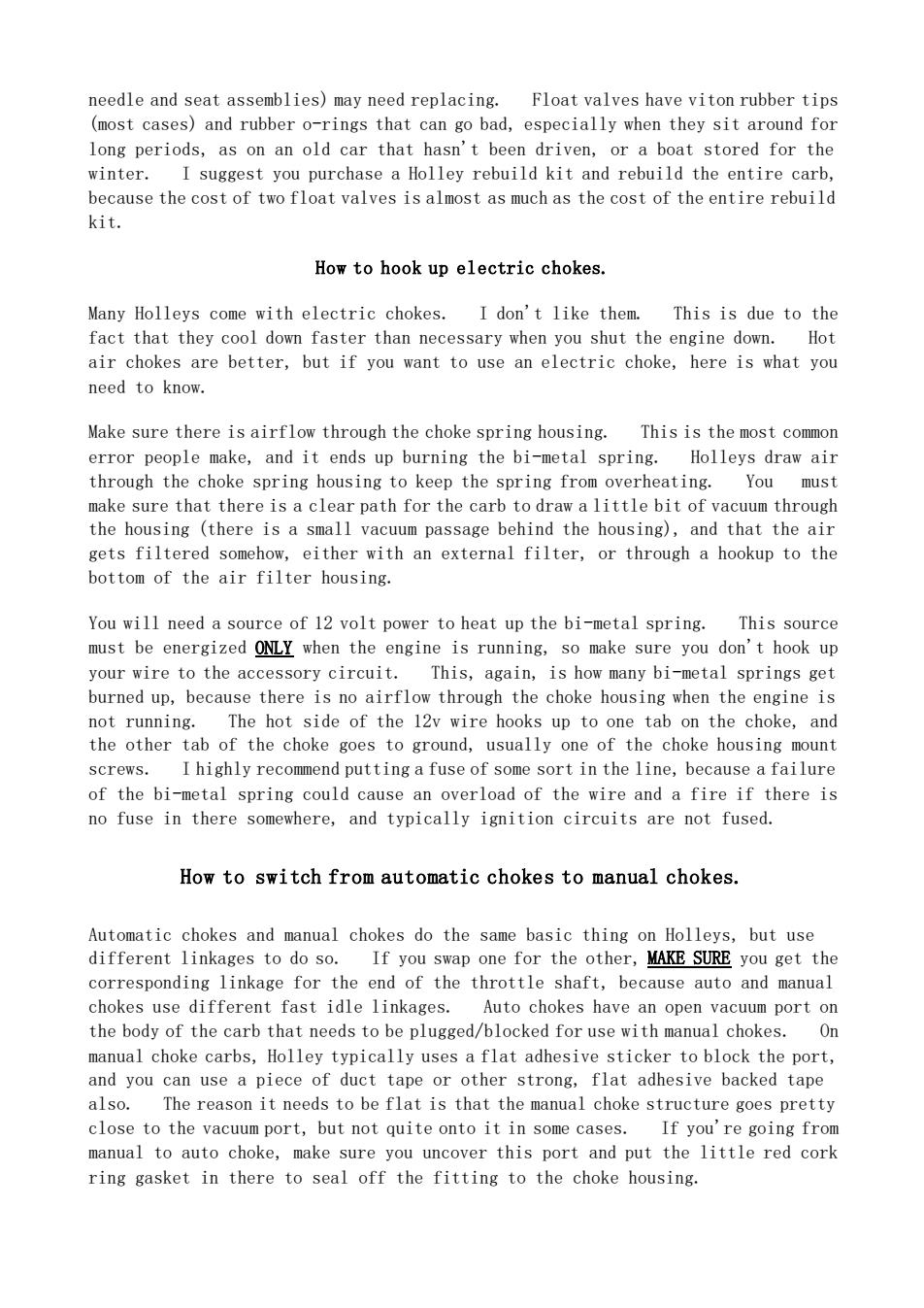
needleandseatassemblies)mayneedreplacing.Floatvalveshavevitonrubbertips(most cases) and rubber o-rings that can go bad, especially when they sit around forlong periods, as on an old car that hasn't been driven,or a boat stored for thewinter.I suggest you purchase a Holleyrebuildkit and rebuild the entire carb,becausethecostof twofloatvalvesisalmost asmuchasthecostof theentirerebuildkit.How to hook up electric chokes.ManyHolleys comewith electric chokes.Idon't likethem.This is due to thefact that they cool down faster than necessary when you shut the engine down.Hotair chokes are better, but if you want to use an electric choke, here is what youneed to know.Make sure there is airflow through the choke spring housing.Thisis themost commonerror people make, and it ends up burning the bi-metal spring.Holleys draw airYouthrough the choke spring housing to keep the spring from overheating.mustmake sure that there is a clear path for the carb to draw a little bit of vacuum throughthe housing (there is a small vacuum passage behind the housing), and that the airgets filtered somehow, either with an external filter,or through a hookup to thebottom of the air filter housing.You will need a source of 12 volt power to heat up the bi-metal spring.This sourcemust be energized ONLY when the engine is running, so make sure you don't hook upyourwiretotheaccessorycircuit.This,again,is howmanybi-metal springsgetburned up,because there is no airflow through the chokehousingwhen the engine isThehot sideof the12vwirehooksup toonetab on thechoke,andnot running.the other tab of the choke goes to ground, usually one of the choke housing mountscrews.Ihighlyrecommendputtingafuseof some sortin theline,because afailureof the bi-metal spring could cause an overload of the wire and a fire if there isno fuse in there somewhere, and typically ignition circuits are not fusedHowto switch from automatic chokesto manual chokes.Automatic chokes and manual chokes do the same basic thing on Holleys, but usedifferentlinkagesto doso.If youswap onefortheother,MAKESUREyougetthecorresponding linkage for the end of the throttle shaft, because auto and manualchokes use different fast idle linkages.Auto chokes havean open vacuumport onthe body of the carbthat needs to beplugged/blockedforuse with manual chokes.Onmanual choke carbs, Holley typically uses a flat adhesive sticker to block the port,and you can use a piece of duct tape or other strong, flat adhesive backed tapealso.The reason it needs to beflat is that the manual choke structure goes prettyclose to the vacuumport, but not quite onto it in some cases.If you're going frommanual to auto choke, make sure you uncover this port and put the little red corkring gasket in there to seal off the fitting to the choke housing
needle and seat assemblies) may need replacing. Float valves have viton rubber tips (most cases) and rubber o-rings that can go bad, especially when they sit around for long periods, as on an old car that hasn't been driven, or a boat stored for the winter. I suggest you purchase a Holley rebuild kit and rebuild the entire carb, because the cost of two float valves is almost as much as the cost of the entire rebuild kit. How to hook up electric chokes. Many Holleys come with electric chokes. I don't like them. This is due to the fact that they cool down faster than necessary when you shut the engine down. Hot air chokes are better, but if you want to use an electric choke, here is what you need to know. Make sure there is airflow through the choke spring housing. This is the most common error people make, and it ends up burning the bi-metal spring. Holleys draw air through the choke spring housing to keep the spring from overheating. You must make sure that there is a clear path for the carb to draw a little bit of vacuum through the housing (there is a small vacuum passage behind the housing), and that the air gets filtered somehow, either with an external filter, or through a hookup to the bottom of the air filter housing. You will need a source of 12 volt power to heat up the bi-metal spring. This source must be energized ONLY when the engine is running, so make sure you don't hook up your wire to the accessory circuit. This, again, is how many bi-metal springs get burned up, because there is no airflow through the choke housing when the engine is not running. The hot side of the 12v wire hooks up to one tab on the choke, and the other tab of the choke goes to ground, usually one of the choke housing mount screws. I highly recommend putting a fuse of some sort in the line, because a failure of the bi-metal spring could cause an overload of the wire and a fire if there is no fuse in there somewhere, and typically ignition circuits are not fused. How to switch from automatic chokes to manual chokes. Automatic chokes and manual chokes do the same basic thing on Holleys, but use different linkages to do so. If you swap one for the other, MAKE SURE you get the corresponding linkage for the end of the throttle shaft, because auto and manual chokes use different fast idle linkages. Auto chokes have an open vacuum port on the body of the carb that needs to be plugged/blocked for use with manual chokes. On manual choke carbs, Holley typically uses a flat adhesive sticker to block the port, and you can use a piece of duct tape or other strong, flat adhesive backed tape also. The reason it needs to be flat is that the manual choke structure goes pretty close to the vacuum port, but not quite onto it in some cases. If you're going from manual to auto choke, make sure you uncover this port and put the little red cork ring gasket in there to seal off the fitting to the choke housing